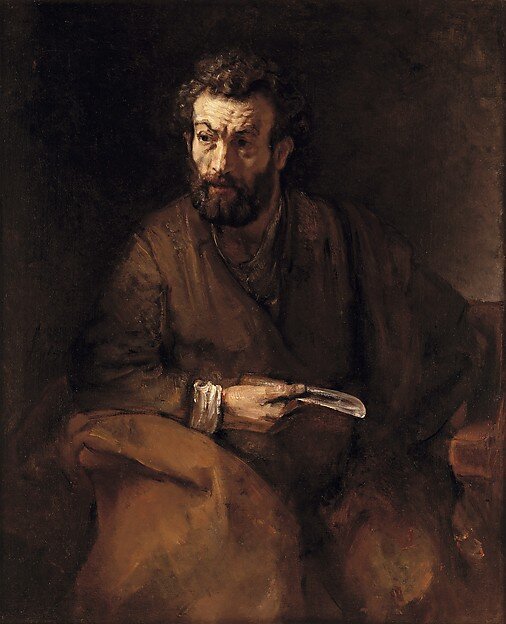Rembrandt, Saint Bartholomew, 1657
Rembrandt (Rembrandt van Rijn) (Dutch, Leiden 1606–1669 Amsterdam), Saint Bartholomew, 1657. Oil on canvas, 48 5/16 × 39 1/4 in. (122.7 × 99.7 cm) Framed: 64 × 56 in. (162.6 × 142.2 cm). Timken Museum of Art, Putnam Foundation Collection, San Diego (34.19) © Timken Museum of Art, San Diego
In the 1650s and 1660s, Rembrandt undertook numerous depictions of the apostles that are notable for their psychological intensity and painterly style. Sober and inward-looking, these representations may have been influenced by both the artist’s personal difficulties and his interest in the teachings of certain religious groups, such as the Mennonites.
Bartholomew is mentioned only briefly in the Gospels, but his life as described in the medieval Golden Legend culminates in martyrdom by flaying. Rembrandt shows him almost casually holding the knife that would torture him. The artist used a method in which the brownish tonal underlayer remains visible in many areas of the canvas. One of his students wrote about Rembrandt’s unusual, abbreviated technique, saying it was a way of leaving alone things that were "fortuitously apt when first laid in." The sentiment echoes the Roman author Pliny’s praise of artists who knew when to take their hand from a picture.
This work is exhibited in the “Unfinished: Thoughts Left Invisible” exhibition, on view through September 4th, 2016. #MetBreuer

/https%3A%2F%2Fprofilepics.canalblog.com%2Fprofilepics%2F1%2F0%2F100183.jpg)
/https%3A%2F%2Fstorage.canalblog.com%2F03%2F02%2F119589%2F96711876_o.jpg)
/https%3A%2F%2Fstorage.canalblog.com%2F11%2F31%2F119589%2F94773502_o.jpg)
/https%3A%2F%2Fstorage.canalblog.com%2F20%2F83%2F119589%2F94772815_o.jpg)
/https%3A%2F%2Fstorage.canalblog.com%2F26%2F72%2F119589%2F75604929_o.jpg)
/https%3A%2F%2Fstorage.canalblog.com%2F59%2F60%2F119589%2F26458628_o.jpg)



/http%3A%2F%2Fstorage.canalblog.com%2F84%2F73%2F119589%2F128782095_o.jpeg)
/http%3A%2F%2Fstorage.canalblog.com%2F46%2F22%2F119589%2F122366228_o.jpg)
/http%3A%2F%2Fstorage.canalblog.com%2F56%2F77%2F119589%2F117688917_o.jpg)
/http%3A%2F%2Fstorage.canalblog.com%2F19%2F40%2F119589%2F112043921_o.jpg)